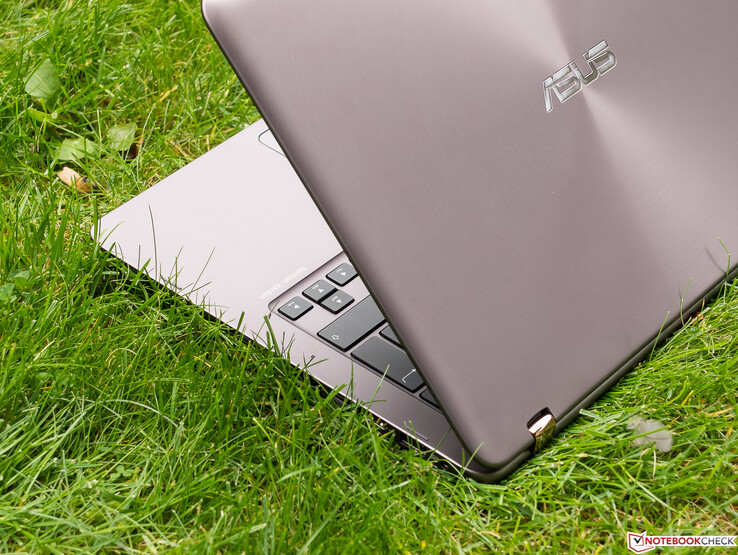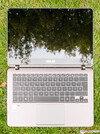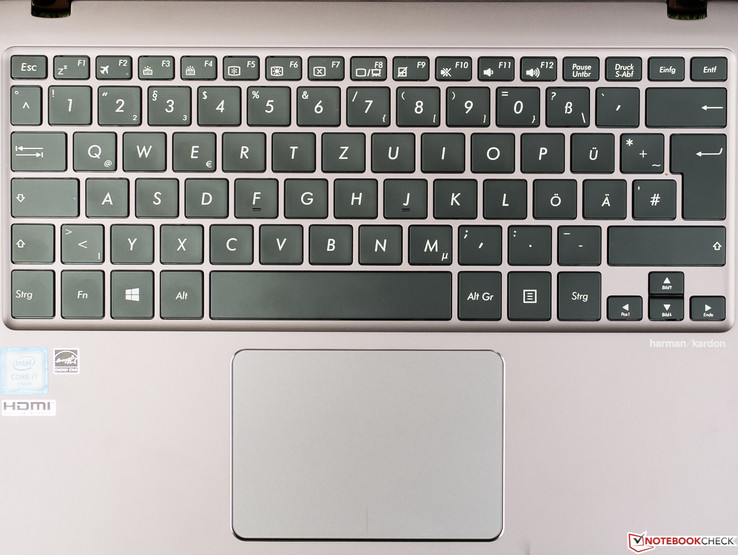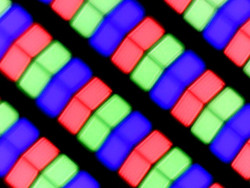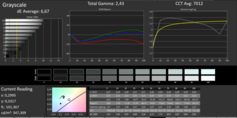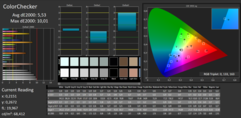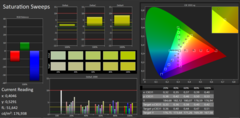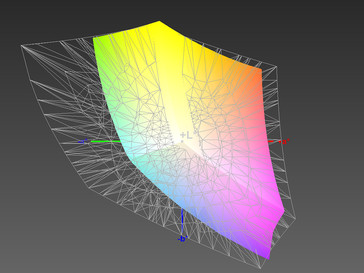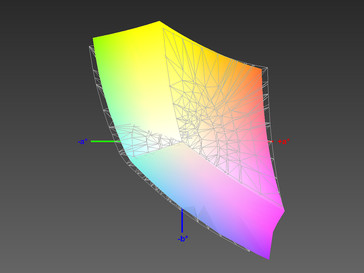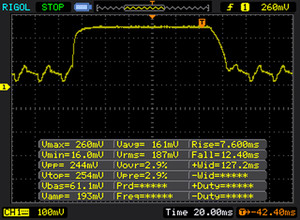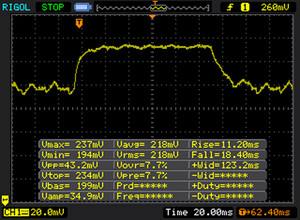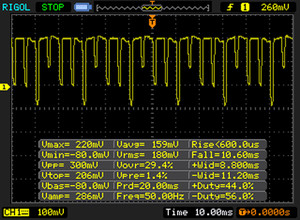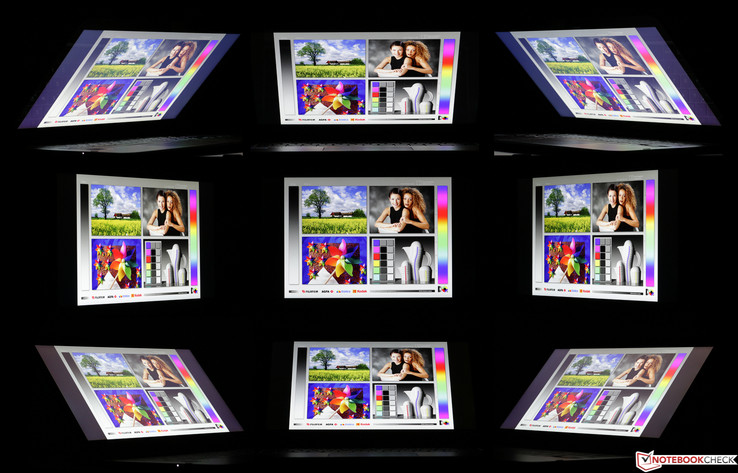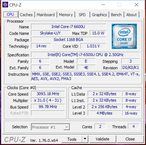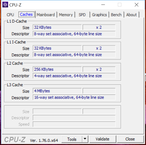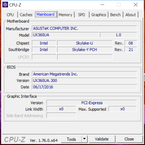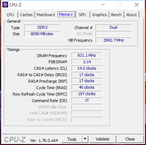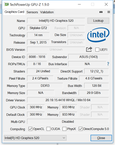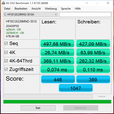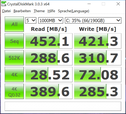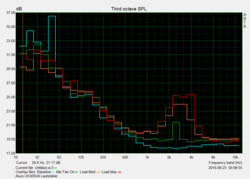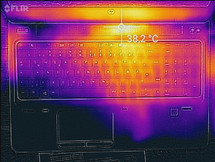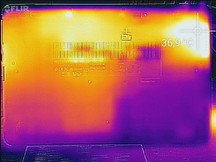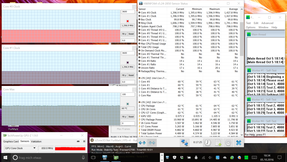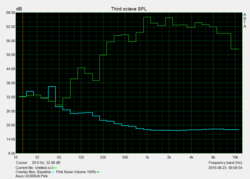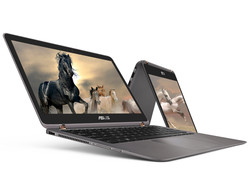Asus ZenBook UX360UA Convertible Review

For the original German review, see here.
Asus ZenBook series in particular stands for mobile laptops, ultrabooks, and convertibles that always come in high-quality looking, cool aluminum casings. A distinctive feature is the concentric, brushed metal finish on the back (circular pattern) where Asus' logo adorns the center. Our review sample is named Asus ZenBook Flip UX360UA-C4159T, and is among the range of 360-degree hinge convertibles that can be used in different modes, such as Laptop, Tablet or Stand for presentations. In the Tablet Mode, the input devices are on the underside and Asus' FlipLock should actually disable them, but this did not function in the test.
In terms of configuration, even though the new ZenBook lacks such security features as a TPM chip or fingerprint scanner, it can still be classified in the upper office or business range. The installed Intel Core i7-6500U ensures decent computing power, which is adequately supported by 8 GB of RAM. The Intel HD 520 GPU that has been integrated into the processor takes care of graphic calculations. The screen in our review sample is a glossy, Full HD IPS panel. A generous 512 GB SSD serves as the storage device. Windows 10 Home is preloaded.
Six different UX360UA models with prices ranging from around 900 to 1200 Euros (~$979 to ~$1305) were listed on a major German price comparison site at the time of testing. Our review sample is the most expensive, with the highest configuration. According to Asus' website, it is also possible to select a somewhat slower Core i5-6200U, up to 16 GB of RAM, different screen (see Display section), and SSDs with capacities of 128 or 256 GB. The models have all other configuration features in common.
Since the size of the 12 and the 13-inch devices are very similar, we have selected devices with identical prices and innovations for comparison. The following convertibles have been used for comparison in this report:
- Acer Aspire R13 R7-372T-746N (13.3-inch)
- HP Spectre x2 12-a001ng (12-inch)
- Lenovo ThinkPad Yoga 260 20FD001XGE (12.5-inch)
Acer's and HP's devices use different constructions, while Lenovo's Yoga also features a 360-degree hinge. At the time of testing in January this year, Lenovo's device was not quite in line in terms of price with a price tag of about 1500 Euros (~$1632), but since then its price has fallen and now fits well into the price range of the rivals.
Case
Apart from the typical ZenBook back, the color that the manufacturer calls as "Rose Gold" ("Quartz Gray" is also available) and the rounded corners, Asus claims that it has redesigned the hinges that are now colored in a particularly eye-catching copper tone. However, the hinges are also the biggest point of criticism in this test.
Although the convertible can be opened easily with one hand, the loosely pulled hinges simply cannot hold the lid in certain angles. The device shuts when opened to approximately just 45°. When the lid is opened to roughly 135° from 180°, the lid falls back to 180°. And, the slightest movements and jolts are enough to rock the lid inadvertently. Not only is this not justifiable in this price range, the tester has never experienced this even in 300-Euro (~$326) devices. We have asked Asus to comment on this or send us a replacement for clarifying this issue for this test, and we will publish the results in an update. Regardless of this, we give the hinges a sub-score of 1.5 out of 5 possible points for the present, and we also reduce the superordinate casing sub-rating by 10%.
We liked the solid base better. Although it is thin, it could be warped to a very limited degree with some effort, and only sometimes creaked slightly during our attempts. The lid is not particularly robust and twists only slightly in the aluminum back area, proving to be quite resilient to pressure. Like the very similar looking yet much cheaper Asus ZenBook UX360CA that we tested in June, the screen is float-mounted in the bezel, which prevents damages caused by lid deformations. There is no cause for criticizm in terms of the apparently first-rate quality workmanship.
We replaced our comparison convertibles with some 13-inch devices for better comparability in this section. As clearly evident, our review sample is one of the lightest and slimmest devices in the field. The ZenBook UX360CA-FC060T sister model is only marginally heavier and thicker, while Dell's Inspiron 13 5368 weighs approximately 400 grams (~14 oz) more and is, above all, much thicker. Lenovo's Yoga Pro 3 weighs almost as much as the ZenBook UX360UA, but it is roughly one centimeter (~0.4 in) wider. The 1.5 kg (~3.3 lb) Acer's Aspire R13 is the heaviest here.
Connectivity
Due to its size, the ZenBook offers only a limited selection of connectivity options. In addition to two conventional USB 3.0 ports, at least a USB 3.1 Type-C Gen.1 is present. Furthermore, enough room was available for a standard HDMI, making an adapter superfluous. Apart from one USB 3.0, all ports are on the right and situated in the back and center areas on the sides. This is an ergonomic advantage when using, for example, an external mouse.
SD Card Reader
We tested the card reader's transfer speeds with our Toshiba Exceria Pro SDXC 64 GB UHS-II reference memory card. The outcomes are sobering since it does not exceed the USB 2.0 standard. Users who frequently transfer large volumes of photos to the Asus should invest in an external USB 3.0 card reader for little money.
| SD Card Reader | |
| average JPG Copy Test (av. of 3 runs) | |
| Asus Zenbook UX360UA-C4159T | |
| Acer Aspire R13 R7-372T-746N | |
| maximum AS SSD Seq Read Test (1GB) | |
| Asus Zenbook UX360UA-C4159T | |
| Acer Aspire R13 R7-372T-746N | |
Communication
The approximately two-year-old Intel Dual Band Wireless-AC 7265 is responsible for wireless communication. As the name suggests, it supports IEEE 802.11 ac that exclusively transmits in the less frequented 5 GHz band as well as in the traditional b, g, and n standards in the 2.4 GHz band. A maximum gross data rate of 867 Mbit/s (MIMO 2x2) was achieved in the 5 GHz band. As always, Bluetooth is integrated. It can be used after updating the driver to version 4.2 at latest.
Although HP's Spectre x2 is equipped with the same Wi-Fi module, it lags behind the review sample by about 13 to 38% under identical, ideal conditions. Considering the overhead, not more can be expected than what our ZenBook delivers - very good.
| Networking | |
| iperf Server (receive) TCP 1 m | |
| Asus Zenbook UX360UA-C4159T | |
| HP Spectre x2 12-a001ng | |
| iperf Client (transmit) TCP 1 m | |
| Asus Zenbook UX360UA-C4159T | |
| HP Spectre x2 12-a001ng | |
Accessories
The box contains only the basic items such as the usual warranty and setup instructions and the power supply. Since no recovery media is included, the recovery partition should be left untouched.
Maintenance
A maintenance hatch or battery that can be removed from the outside should not be expected in a 13-inch convertible. The innards can only be reached after dismantling the base plate. Asus makes doing this even more difficult by using Torx screws.
Warranty
Asus includes a 24-month manufacturer warranty (pick-up & return). Naturally, the legal retailer’s warranty applies. Please see our Guarantees, Return Policies & Warranties FAQ for country-specific information.
Input Devices
Keyboard
A three-level, evenly backlit, and impeccably lettered chiclet keyboard is installed. It is just as wide as a standard desktop model (without number pad). The flat, slip-resistant keys are adequately sized, and not too cramped. Since the layout does not hold any surprises, the tester achieved a decent typing speed.
The keyboard mat can be dented in the center and toward the right, but this is not noticeable when typing normally on it. The low drop, noticeable yet not exactly crisp pressure point, and the relatively soft stroke define the spongy typing experience. Asus' ZenBook UX360UA is not quite suitable for noise-sensitive environments since the big keys clatter audibly compared to the smaller ones.
Touchpad
In relation to the casing's dimensions, the ClickPad without physically separated keys is pleasantly sized. However, it is not touch-sensitive into the outer edges. The tester had some problems with the gliding properties because just slightly or even normally moist fingers tended to stick to the sleek surface. The mouse cursor could be moved accurately, but sometimes it did not execute fast movements. Mouse gestures using up to three fingers are mostly implemented reliably.
The low-drop replacement mouse keys do not provide much feedback. The pressure point is perhaps a bit soft, but a pleasingly defined acoustic feedback is produced when triggered.
Touchscreen
We did not have any problems with the 10-point touchscreen in the test. It is touch-sensitive into the corners, precise, and responsive.
Display
A glossy, IPS-based, Full HD touchscreen is installed. The almost 2 million pixels distributed over 13.3 inches result in a decent pixel density of 166 PPI. The tester cannot complain about a pixelated reproduction, even close up with his new glasses. The image sharpness cannot be criticized either. According to Asus' ZenBook website, the following panels are available:
- LED backlit QHD+ (3200x1800) 60 Hz Glossy Touchscreen with 72% NTSC
- LED backlit FHD (1920x1080) 60 Hz Glossy Touchscreen with 72% NTSC
- LED backlit FHD (1920x1080) 60 Hz Glossy Touchscreen with 45% NTSC
Support ASUS Splendid Technology
With IPS Technology
Asus does not show any weaknesses in terms of brightness and contrast - quite the opposite. In addition to the superb maximum brightness of 326 cd/m², the very low black level of just 0.27 cd/m² is responsible for the outstanding contrast ratio of 1274:1. The ZenBook's screen does not particularly stand out within the test field. Despite its slightly lower brightness, Acer's Aspire achieves a tremendous contrast of 1882:1 thanks to its fantastic black level of 0.17 cd/m² (!), while HP's Spectre achieves "only" 802:1 because the black level of 0.44 cd/m² is rather too high here.
The measured illumination of 86% is inconspicuous at first. Visible backlight bleeding is seen in both left corners and at the right edge when looking at a completely black screen using maximum brightness. However, in practice they are only noticed in very dark screen contents.
| |||||||||||||||||||||||||
Brightness Distribution: 86 %
Center on Battery: 344 cd/m²
Contrast: 1274:1 (Black: 0.27 cd/m²)
ΔE ColorChecker Calman: 5.53 | ∀{0.5-29.43 Ø4.78}
ΔE Greyscale Calman: 6.67 | ∀{0.09-98 Ø5}
93% sRGB (Argyll 1.6.3 3D)
60% AdobeRGB 1998 (Argyll 1.6.3 3D)
66% AdobeRGB 1998 (Argyll 3D)
93.1% sRGB (Argyll 3D)
64.8% Display P3 (Argyll 3D)
Gamma: 2.43
CCT: 7012 K
| Asus Zenbook UX360UA-C4159T AU Optronics AOU272D / B133HAN02.7, , 1920x1080, 13.3" | Acer Aspire R13 R7-372T-746N Sharp LQ133T1JW02, , 2560x1440, 13.3" | HP Spectre x2 12-a001ng LGD04A5, , 1920x1280, 12" | Lenovo ThinkPad Yoga 260 20FD001XGE LEN40E6 N125HCE-GN1, , 1920x1080, 12.5" | |
|---|---|---|---|---|
| Display | 6% | -20% | -33% | |
| Display P3 Coverage (%) | 64.8 | 69.6 7% | 52.9 -18% | 42.98 -34% |
| sRGB Coverage (%) | 93.1 | 98 5% | 71.8 -23% | 62.8 -33% |
| AdobeRGB 1998 Coverage (%) | 66 | 70.7 7% | 52.6 -20% | 44.55 -32% |
| Response Times | -41% | -54% | -90% | |
| Response Time Grey 50% / Grey 80% * (ms) | 29 ? | 36 ? -24% | 51 ? -76% | 64 ? -121% |
| Response Time Black / White * (ms) | 19 ? | 30 ? -58% | 25 ? -32% | 30 ? -58% |
| PWM Frequency (Hz) | 50 ? | 1000 ? | ||
| Screen | 17% | -15% | -26% | |
| Brightness middle (cd/m²) | 344 | 320 -7% | 353 3% | 371 8% |
| Brightness (cd/m²) | 326 | 308 -6% | 347 6% | 335 3% |
| Brightness Distribution (%) | 86 | 91 6% | 91 6% | 84 -2% |
| Black Level * (cd/m²) | 0.27 | 0.17 37% | 0.44 -63% | 0.29 -7% |
| Contrast (:1) | 1274 | 1882 48% | 802 -37% | 1279 0% |
| Colorchecker dE 2000 * | 5.53 | 3.18 42% | 6.09 -10% | 8.51 -54% |
| Colorchecker dE 2000 max. * | 10.01 | 9.91 1% | 20.43 -104% | |
| Greyscale dE 2000 * | 6.67 | 4.13 38% | 6.24 6% | 9.23 -38% |
| Gamma | 2.43 91% | 2.03 108% | 2.41 91% | 2.24 98% |
| CCT | 7012 93% | 6752 96% | 7238 90% | 6759 96% |
| Color Space (Percent of AdobeRGB 1998) (%) | 60 | 65 8% | 46 -23% | 41 -32% |
| Color Space (Percent of sRGB) (%) | 93 | 98 5% | 71 -24% | 62 -33% |
| Total Average (Program / Settings) | -6% /
7% | -30% /
-22% | -50% /
-36% |
* ... smaller is better
Apart from backlight bleeding, black looks subjectively rich. Even if ambitious image editors will normally prefer larger monitors, they will be pleased with the large, 93% coverage of the small sRGB standard color space (AdobeRGB: 60%), which is aligned for most picture recording and playback devices in the consumer range. Our Acer Aspire can display a few more colors, as it achieves 98% of the sRGB and 65% of the large AdobeRGB color space.
Acer's convertible also shines with color accuracy in the state of delivery. It is close to the ideal rates of less than DeltaE 3, which is not quite true for the review sample. Consequently, a slight and not very visible color tint towards light green can be observed in our review sample. Using the color profile linked in the box might eliminate this.
The ever present reflections ergonomically restrict the use of the laptop in the outdoors even on a cloudy day if the laptop is not positioned accurately to prevent bright areas such as the sky (left screenshot), from being reflected on the screen. The right screenshot that we photographed with the door in the back illustrates what is possible in this ambient light.
Display Response Times
| ↔ Response Time Black to White | ||
|---|---|---|
| 19 ms ... rise ↗ and fall ↘ combined | ↗ 7 ms rise | |
| ↘ 12 ms fall | ||
| The screen shows good response rates in our tests, but may be too slow for competitive gamers. In comparison, all tested devices range from 0.1 (minimum) to 240 (maximum) ms. » 41 % of all devices are better. This means that the measured response time is similar to the average of all tested devices (20.2 ms). | ||
| ↔ Response Time 50% Grey to 80% Grey | ||
| 29 ms ... rise ↗ and fall ↘ combined | ↗ 11 ms rise | |
| ↘ 18 ms fall | ||
| The screen shows relatively slow response rates in our tests and may be too slow for gamers. In comparison, all tested devices range from 0.165 (minimum) to 636 (maximum) ms. » 38 % of all devices are better. This means that the measured response time is similar to the average of all tested devices (31.6 ms). | ||
Screen Flickering / PWM (Pulse-Width Modulation)
| Screen flickering / PWM detected | 50 Hz | ≤ 40 % brightness setting | |
The display backlight flickers at 50 Hz (worst case, e.g., utilizing PWM) Flickering detected at a brightness setting of 40 % and below. There should be no flickering or PWM above this brightness setting. The frequency of 50 Hz is very low, so the flickering may cause eyestrain and headaches after extended use. In comparison: 53 % of all tested devices do not use PWM to dim the display. If PWM was detected, an average of 8111 (minimum: 5 - maximum: 343500) Hz was measured. | |||
In terms of viewing angle stability, we are dealing with a good, yet not outstanding panel for IPS conditions. As the corner photos of our collage show, no matter how flat the viewing angle is horizontally or vertically (!) - colors only distort slightly when looking at the screen from above. Brightness, and consequently contrast losses are kept within tight limits when moving normally in front of the screen and are only noticed in particularly flat angles. This screen is unconditionally suitable for the Tablet Mode.
Performance
The performance of Asus' ZenBook Flip UX360UA principally makes it a beefed-up office computer that copes with even sophisticated software, such as Adobe Photoshop, thanks to the feasible dual-core CPU with Hyperthreading, enough memory, and a large SSD that will usually ensure an absolutely smooth-running system. The only two existing physical cores and primarily the weak processor graphics will thwart playing up-to-date 3D games.
Processor
Probably there is not that much of a measurable performance gain with the higher clocked Intel Core i7-6500U (2x 2.5-3.1 GHz, Hyperthreading, TDP: 15W) compared to the cheaper basic i5-6200UCPU (2x 2.3-2.8 GHz, Hyperthreading, TDP: 15W), which we believe would also have sufficed in view of the convertible's purpose in routine use. The efficient Skylake dual-core model that is suitable for even slimmer models than the review sample achieves a maximum Turbo speed of 3.0 GHz when both cores are loaded. Although for the first time DDR4 RAM support is on board, Asus has opted for the slower DDR3 memory. The CPU has to share the tight TDP with the integrated Intel HD 520 graphics unit.
Demanding software is not much of a challenge for the processor as long as it does not benefit clearly from four or more physical cores due to high parallelization, as is the case in many current games. Compared with other laptops based on the same CPU, the performance is within the expected range. Turbo utilization was not absolutely satisfactory in our Cinebench R15 multi-core loop. The clock rates ranged from 2.7 to 3.0 GHz with an average of almost 2850 MHz. The scores do not change in battery mode.
System Performance
As expected in view of the configuration of the included SSD, the performance of Asus' ZenBook UX360UA is more than smooth. Cold starts and opening programs are fast, and excessive multitasking using diverse tabs in the memory-driven Chrome browser (improvements have been announced) hardly let the laptop stumble.
The scores of PCMark 8 used for evaluation are on the level of comparably configured laptops. The outcomes are quite close to each other in the field of the comparison laptops; only HP's Spectre x2 clearly lags behind with its considerably slower 4.5-watt CPU.
| PCMark 8 | |
| Home Score Accelerated v2 | |
| Asus Zenbook UX360UA-C4159T | |
| Lenovo ThinkPad Yoga 260 20FD001XGE | |
| Acer Aspire R13 R7-372T-746N | |
| HP Spectre x2 12-a001ng | |
| Work Score Accelerated v2 | |
| Lenovo ThinkPad Yoga 260 20FD001XGE | |
| Asus Zenbook UX360UA-C4159T | |
| Acer Aspire R13 R7-372T-746N | |
| PCMark 8 Home Score Accelerated v2 | 3435 points | |
| PCMark 8 Work Score Accelerated v2 | 4315 points | |
Help | ||
Storage Device
Since the installed Hynix SSD is connected via SATA 3, transfer rates of well over 500 MB/s should not be generally expected. According to CrystalDiskMark 3.0, this limit is unusually clearly undercut in sequential read processes. Thus, Hynix ends up in the last place here without affecting the routine use significantly. Then again, the SSD scores in the sequential write performance. It is exactly the other way around with the SSD in HP's Spectre x2, which should be preferred because the read performance is far more important.
The read performance of small, random data blocks (Read 4k) as typical for OS and program starts is also interesting. We can give a "Good" at 30 MB/s in this test, but the ZenBook just misses that. A read performance of approximately 40 MB/s and above would be very good. Overall, the performance of Hynix' SSD can be called average, although it will naturally outperform every conventional hard drive.
| Asus Zenbook UX360UA-C4159T SK Hynix Canvas SC300 512GB M.2 (HFS512G39MND) | Acer Aspire R13 R7-372T-746N Lite-On CV1-8B256 | HP Spectre x2 12-a001ng Liteon L8H-256V2G | Lenovo ThinkPad Yoga 260 20FD001XGE Samsung SSD PM871 MZNLN256HCHP | |
|---|---|---|---|---|
| CrystalDiskMark 3.0 | 3% | -15% | -1% | |
| Read Seq (MB/s) | 452.1 | 507 12% | 517 14% | 468.9 4% |
| Write Seq (MB/s) | 421.3 | 354.4 -16% | 270.1 -36% | 297.3 -29% |
| Read 512 (MB/s) | 288.6 | 355.3 23% | 369.2 28% | 397.9 38% |
| Write 512 (MB/s) | 310.7 | 353.9 14% | 264.6 -15% | 297.1 -4% |
| Read 4k (MB/s) | 28.52 | 32.66 15% | 23.48 -18% | 33.11 16% |
| Write 4k (MB/s) | 72.1 | 81.6 13% | 57.4 -20% | 85.1 18% |
| Read 4k QD32 (MB/s) | 389.6 | 277.6 -29% | 223.4 -43% | 398.3 2% |
| Write 4k QD32 (MB/s) | 285.3 | 261.2 -8% | 195.8 -31% | 136.6 -52% |
Graphics Card
We refer to our corresponding page in the FAQ section for comprehensive information and benchmarks concerning the processor-integrated Intel HD 520 graphics unit without a dedicated memory. The power-efficient GPU copes easily with 2D-tasks but has to give up quickly when 3D-calculations have to be performed. The fact that the model in the ZenBook UX360UA is one of the fastest in our database does not change this either.
| 3DMark 11 - 1280x720 Performance GPU | |
| Asus Zenbook UX360UA-C4159T | |
| Acer Aspire R13 R7-372T-746N | |
| Lenovo ThinkPad Yoga 260 20FD001XGE | |
| 3DMark - 1280x720 Cloud Gate Standard Graphics | |
| Asus Zenbook UX360UA-C4159T | |
| Acer Aspire R13 R7-372T-746N | |
| Lenovo ThinkPad Yoga 260 20FD001XGE | |
| 3DMark 11 Performance | 1651 points | |
| 3DMark Ice Storm Standard Score | 65139 points | |
| 3DMark Cloud Gate Standard Score | 5832 points | |
Help | ||
Gaming Performance
There is not much to say here either. Of the three tested games, only "BioShock Infinite" from 2013 actually runs smoothly at the lowest settings. The average (!) 32 FPS in "Battlefield 4" is not enough for a shooter. More current blockbusters, such as "Witcher 3", degenerate to an unplayable stutter bash. It looks better with isometric games such as "FIFA 16", "Sims 4", etc. The GPU sometimes manages relatively basic 3D games like "Counter Strike: GO" from 2012 even in high settings at 1366x768 pixels.
| low | med. | high | ultra | |
|---|---|---|---|---|
| BioShock Infinite (2013) | 49.5 | 29.2 | 24.5 | |
| Battlefield 4 (2013) | 32.2 | 24.8 | ||
| The Witcher 3 (2015) | 13.6 |
Emissions
System Noise
While idling, the permanently running fan can hardly be discerned from the ambient noise in a quiet, one-person office from a normal distance of half a meter (~20 in). Opening a YouTube video in Full HD does not cause the fan to speed up either. We tried to speed up the fan with Prime95 and FurMark, but that did not really work. It did not go beyond a perhaps very quiet noise that was still audible at a distance of two meters (~6.5 ft) even in this unrealistic stress test scenario. Magic is not needed to cool a modern 15-watt processor noiselessly. Our ZenBook performs this task convincingly.
Noise level
| Idle |
| 30.5 / 32.1 / 32.3 dB(A) |
| HDD |
| 32 dB(A) |
| DVD |
| 37.6 / dB(A) |
| Load |
| 36.1 / 36.1 dB(A) |
 | ||
30 dB silent 40 dB(A) audible 50 dB(A) loud |
||
min: | ||
Temperature
The maximum surface temperature of just 33 °C (~91 °F) during the stress test makes saying anything here superfluous.
The frequency-response curve during the aforementioned stress test via Prime95 + FurMark is more interesting. The low TDP of 15 watts finds its limits when the CPU and the integrated GPU are fully loaded at the same time, which results in significant throttling. It was not enough for more than 1.4 GHz (CPU) and 850 MHz (GPU) here. This behavior is not an exclusive shortcoming of the review sample, but typical for ULV processors.
(+) The maximum temperature on the upper side is 31.3 °C / 88 F, compared to the average of 35.4 °C / 96 F, ranging from 19.6 to 60 °C for the class Convertible.
(+) The bottom heats up to a maximum of 33.3 °C / 92 F, compared to the average of 36.8 °C / 98 F
(+) In idle usage, the average temperature for the upper side is 24 °C / 75 F, compared to the device average of 30.3 °C / 87 F.
(+) The palmrests and touchpad are cooler than skin temperature with a maximum of 26.3 °C / 79.3 F and are therefore cool to the touch.
(±) The average temperature of the palmrest area of similar devices was 27.9 °C / 82.2 F (+1.6 °C / 2.9 F).
Speakers
The sound usually suffers under especially compact and slim casings like that of the review sample because there is hardly any resonant cavity. The manufacturers often use tweaks that, for example, reproduce non-reproducible bass frequencies in higher tone ranges psycho-acoustically. Consequently, this often leads to an unnatural playback. The sound of our ZenBook can be characterized as very mids and treble heavy and audibly compressed.
Although there is no hint of real bass, the user can be pleased with the feasible dynamics, and surround does not come too short either. The speakers reduce the volume when many loud instruments are played simultaneously, which can lead to unpleasant volume fluctuations. However, distortions did not occur in the framework of our tests. The sound tends to blend at high volumes in bass-heavy metal music. Voices in videos and games are quite understandable and sound more natural than most music pieces. The Realtek driver offers virtually no settings at all. Overall, the UX360UA does quite a satisfactory job for a convertible of this size.
Asus Zenbook UX360UA-C4159T audio analysis
(-) | not very loud speakers (66 dB)
Bass 100 - 315 Hz
(±) | reduced bass - on average 14.1% lower than median
(±) | linearity of bass is average (14.2% delta to prev. frequency)
Mids 400 - 2000 Hz
(+) | balanced mids - only 3.3% away from median
(±) | linearity of mids is average (7.2% delta to prev. frequency)
Highs 2 - 16 kHz
(+) | balanced highs - only 2.9% away from median
(+) | highs are linear (3.8% delta to prev. frequency)
Overall 100 - 16.000 Hz
(±) | linearity of overall sound is average (17.4% difference to median)
Compared to same class
» 32% of all tested devices in this class were better, 8% similar, 60% worse
» The best had a delta of 6%, average was 20%, worst was 57%
Compared to all devices tested
» 32% of all tested devices were better, 8% similar, 60% worse
» The best had a delta of 4%, average was 24%, worst was 134%
HP Spectre x2 12-a001ng audio analysis
(-) | not very loud speakers (67 dB)
Bass 100 - 315 Hz
(-) | nearly no bass - on average 29.3% lower than median
(+) | bass is linear (5.5% delta to prev. frequency)
Mids 400 - 2000 Hz
(±) | higher mids - on average 5.1% higher than median
(±) | linearity of mids is average (13.2% delta to prev. frequency)
Highs 2 - 16 kHz
(±) | higher highs - on average 8.9% higher than median
(+) | highs are linear (6.5% delta to prev. frequency)
Overall 100 - 16.000 Hz
(-) | overall sound is not linear (34.2% difference to median)
Compared to same class
» 93% of all tested devices in this class were better, 2% similar, 5% worse
» The best had a delta of 6%, average was 20%, worst was 57%
Compared to all devices tested
» 93% of all tested devices were better, 1% similar, 6% worse
» The best had a delta of 4%, average was 24%, worst was 134%
Frequency diagram in comparison (check boxes above can be turned on/off!)
Energy Management
Power Consumption
Comparing the consumption behavior of the ZenBook with those of other 13-inch laptops based on the same CPU and SSD and without a dedicated graphics card shows that the consumption rates in a shutdown state and standby as well as in all other load states are below the average. However, the ZenBook consumes 2.1 watts more in idle min and idle avg, placing it exactly in midfield. Thus, there are no irregularities. The 45-watt power supply can always cope with the demand.
| Off / Standby | |
| Idle | |
| Load |
|
Key:
min: | |
| Asus Zenbook UX360UA-C4159T 6500U, HD Graphics 520, SK Hynix Canvas SC300 512GB M.2 (HFS512G39MND), IPS, 1920x1080, 13.3" | Acer Aspire R13 R7-372T-746N 6500U, HD Graphics 520, Lite-On CV1-8B256, IPS, 2560x1440, 13.3" | HP Spectre x2 12-a001ng 6Y30, HD Graphics 515, Liteon L8H-256V2G, IPS, 1920x1280, 12" | Lenovo ThinkPad Yoga 260 20FD001XGE 6500U, HD Graphics 520, Samsung SSD PM871 MZNLN256HCHP, IPS, 1920x1080, 12.5" | |
|---|---|---|---|---|
| Power Consumption | -18% | 8% | 22% | |
| Idle Minimum * (Watt) | 6.9 | 6.2 10% | 6 13% | 3.6 48% |
| Idle Average * (Watt) | 7.9 | 8 -1% | 8 -1% | 6.3 20% |
| Idle Maximum * (Watt) | 8.3 | 11.6 -40% | 10.6 -28% | 7.6 8% |
| Load Average * (Watt) | 30.1 | 40 -33% | 21.5 29% | 27.2 10% |
| Load Maximum * (Watt) | 29.6 | 36.6 -24% | 22 26% | 22.8 23% |
* ... smaller is better
Battery Runtime
We use the same laptops as in the Power Consumption chapter for analyzing the battery life. However, the laptops filtered in this manner naturally have different battery capacities. Our review sample has 57 Wh. In the maximum runtime test (Our test criteria), Asus' device can sometimes take the second place behind its ZenBook UX305UA-FC040T sibling with an almost equally sized battery (56 Wh).
Both ZenBooks again take the top two places in reverse order in our practical Wi-Fi test using medium brightness - and that with battery runtimes of around 9.5 hours, which should safely get every user through a day. The convertibles used in this test cannot keep up simply due to their lower battery capacities. Acer's Aspire is also a bit too thirsty for its configuration.
| Asus Zenbook UX360UA-C4159T 6500U, HD Graphics 520, 57 Wh | Acer Aspire R13 R7-372T-746N 6500U, HD Graphics 520, 49 Wh | HP Spectre x2 12-a001ng 6Y30, HD Graphics 515, 43 Wh | Lenovo ThinkPad Yoga 260 20FD001XGE 6500U, HD Graphics 520, 44 Wh | |
|---|---|---|---|---|
| Battery runtime | -42% | -27% | -35% | |
| Reader / Idle (h) | 19.4 | 11.2 -42% | 11.4 -41% | 15.7 -19% |
| WiFi v1.3 (h) | 9.7 | 6.4 -34% | 6.1 -37% | 5.8 -40% |
| Load (h) | 2.8 | 1.4 -50% | 2.7 -4% | 1.5 -46% |
| H.264 (h) | 6.6 |
Pros
Cons
Verdict
Our tests evaluate that what we are provided with - in this case, a brand new retail device from the online shop. Unfortunately, the convertible is degraded to quite some degree due to its unsuitable hinges. It is hardly of any use in Laptop Mode or in environments that tend to be shaky like in the car or train. Furthermore, the display often cannot keep the set angle in stationary use, either. The deductions have affected the end rating considerably. We have asked Asus to comment this. The report will be updated in regards to this issue.Our tests evaluate what we are provided with - in this case, a brand new retail device from the online shop. Unfortunately, the convertible is degraded to quite some degree due to its unsuitable hinges. It is hardly of any use in Laptop Mode or in environments that tend to be shaky, such as in the car or on the train. Even in stationary use, the display often cannot maintain the set angle. The deductions have affected the final rating significantly. We have asked Asus to comment on this. The report will be updated regarding this issue.
Close, but no cigar. Its sometimes useless hinges prevent us from giving the light and slim Asus ZenBook Flip UX360UA a purchase recommendation despite its otherwise mostly convincing performance.
Otherwise, there is not much cause for complaint. We find the absence of a maintenance option somewhat aggravating, but that is typical in this category. It remains inconceivable why Torx screws had to be used. The card reader's speed is inappropriate considering the price. And the tester had an unusual number of problems with the touchpad's gliding properties.
The elegant, solid, and yet very light and slim casing is decidedly a plus point. This is also true of the screen, the mostly cool and very quiet system noise, and above all the superb battery life.
Asus Zenbook UX360UA-C4159T
- 10/17/2016 v5.1 (old)
Sven Kloevekorn




